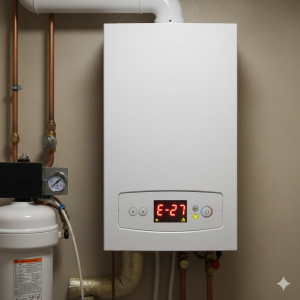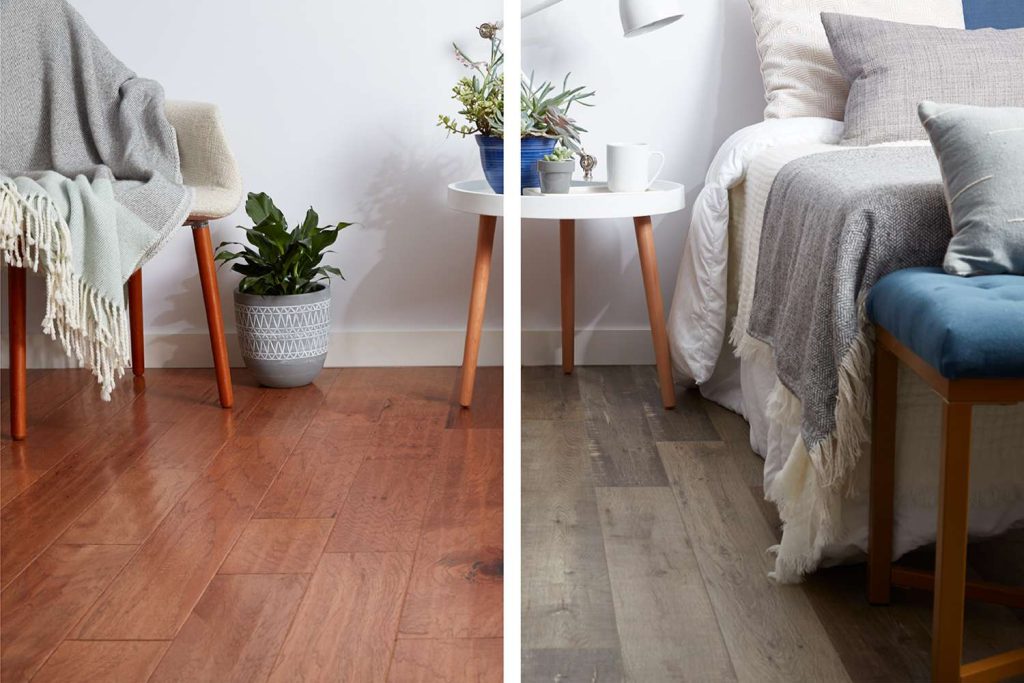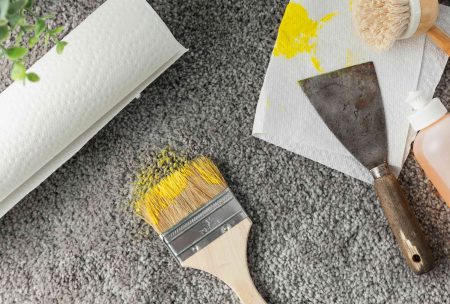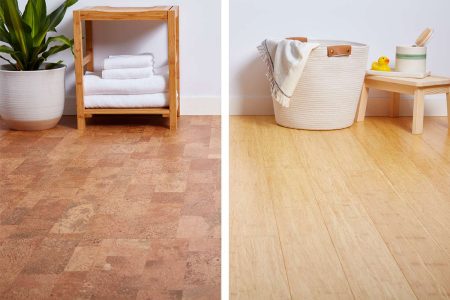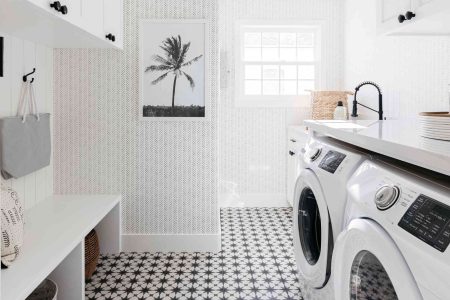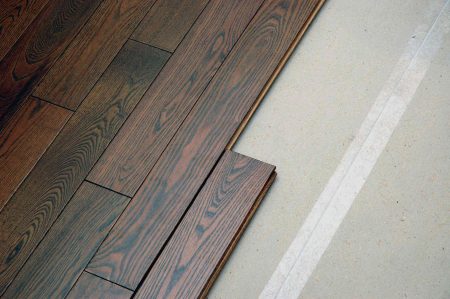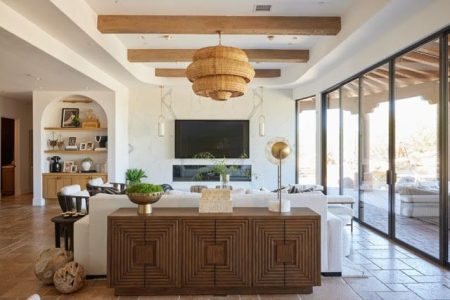Laminate flooring and engineered wood flooring are two obvious choices if you want a flooring that looks like solid hardwood but at a more affordable price. Both floor coverings were developed as economical and versatile alternatives to that mainstay of flooring material—solid hardwood flooring. Both laminate and engineered wood have merits and drawbacks, which you must weigh in order to make the right decision.
Laminate vs. Engineered Wood Flooring
Laminate flooring is a fully man-made material that consists of several layers. The base is fiberboard, with a photographic image layer bonded over the top. Then, a transparent wear layer is applied to protect the surface. The image layer can be printed to resemble many different materials—most types attempt to simulate wood, but there are also stone-look laminates. Recent years have seen innovations that allow embossing and texturizing to the surface, which makes the flooring more realistic. At a distance, these floors can look fairly realistic, though upon close inspection the faux nature becomes apparent to most people.
Engineered wood, on the other hand, is a much more convincing replica of solid hardwood for the simple reason that the surface is genuine wood. Rather than being solid hardwood through-and-through, engineered wood floors bond a relatively thin layer of true hardwood over a substrate of high-quality plywood. This gives the flooring good dimensional stability, and in certain applications it is an even better choice than solid hardwood flooring.
| Engineered Hardwood | Laminate | |
| Appearance | Real hardwood surface | Obvious simulation of wood |
| Cost | Only slightly more affordable than solid hardwood | Very inexpensive |
| Installation | Most types are nail-down or glue-down | Floating floor with interlocking edges |
| DIY or Pro? | Pro installation is more common | Very easy DIY installation |
| Resale Value | Offers better real estate value | Not as prestigious as wood |
| Life Expectancy | 30 years or more | 10 to 20 years on average |
Watch Now: Laminate vs. Engineered Wood Flooring
Appearance
Laminate
Laminate flooring, while it has become better at mimicking wood and other materials, will always come up short as a replica of wood. But top-quality laminates now have a richer, deeper embossing of simulated wood grain textures, giving the flooring a much more realistic feel. Thicker, premium 12 mm laminates, too, have convinced many buyers to experiment with the product in higher-end homes.
Engineered Wood
The biggest advantage that engineered hardwood flooring holds over laminate flooring is that its surface is real hardwood. It will always look better than laminate, especially close-up.
Best for Appearance: Engineered Wood
Both types of flooring come in hundreds of different colors and styles, and you will easily be able to find one that matches your design needs. But for realism, nothing beats engineered wood, because its surface is real, genuine hardwood.
Water and Heat Resistance
Laminate
While some types of laminate are advertised as “water-resistant,” this flooring material has a core layer of fiberboard that can be damaged if water seeps through the many cracks between boards. However, the plastic surface layer is resistant to water damage, provided moisture is mopped up immediately.
Engineered Wood
Engineered wood flooring is usually finished with a very tough, waterproof surface sealer, but both the surface veneer and the plywood base layers are wood, which can swell and warp if they get wet.
Best for Water and Heat Resistance: Tie
Neither laminate or engineered wood is a great choice for humid, damp locations, although both are better than solid hardwood in these situations. Even if the surface is kept well sealed, cracks between engineered wood or laminate boards can allow moisture to penetrate to the organic substrate (plywood or fiberboard), causing it to swell or develop mold. For frequently wet locations, ceramic tile or luxury vinyl are much better choices. Both flooring materials have decent resistance to heat and sunlight.
Durability and Maintenance
Laminate
Of the two flooring materials, laminate flooring is somewhat easier to care for, since the surface layer is plastic and can easily be wiped clean. However, laminate flooring cannot be refinished; when the flooring becomes badly marred, it must be removed and replaced.
Engineered Wood
Engineered hardwood flooring can be sanded and refinished at least once, and if the flooring has a particularly thick veneer layer, you may even be able to refinish it two or three times.
Best for Durability and Maintenance: Engineered Hardwood
These flooring materials are equally easy to care for, but the prefinished engineered hardwood has a very tough surface finish and can be refinished at least once.
Installation
Laminate
Laminate flooring is one of the easiest flooring materials to install, which makes it a favorite of DIYers. The planks are engineered with a unique “click-lock” edge treatment in which the edges of the planks interlock and “float” over a layer of foam underlayment spread over the subfloor. Most people find it possible to cover a room with laminate flooring in an afternoon.
Engineered Wood
Engineered hardwood floors, while often easier to install than solid hardwood, is more likely to require professional installation. These floors are often installed in the same manner as solid hardwood, by blind-nailing them to the subfloor with finish nails or staples driven at an angle through the tongues along the edges of the boards. But there are also floating versions of these floors, and engineered wood floorboards can also be glued down when installing then over a concrete subfloor.
Best for Installation: Laminate
Laminate floors are among the easiest of all flooring materials for DIYers. However, some forms of engineered wood flooring come close for ease of installation.
Cost
Laminate
Here, laminate flooring holds a big advantage, since it is one of the most affordable of all flooring materials. Laminate flooring can be purchased for $1 to $3 per square foot at big-box home improvement centers (although it’s possible to spend $10 to $12 per square foot on designer styles).
Engineered Wood
Engineered wood flooring typically starts at the lowest end at $4 per square foot, but the average is more like $8 per square foot.
And with an engineered wood floor, there is often the added cost of professional installation, which can bring the cost over $25 per square foot. With laminates, on the other hand, the DIY installation is so easy that you often need no professional help.
Best for Cost: Laminate
Low cost is the single biggest advantage that laminate flooring holds over engineered hardwood flooring.
Lifespan
Laminate
Laminate flooring is regarded as a 10- to 20-year flooring material, depending on the original quality of the material and how much wear it received.
Engineered Wood
Engineered wood flooring is more durable, with a lifespan that can easily run 30 years or sometimes much longer.
Best for Lifespan: Engineered Wood
With a lifespan of 30 years or more and the ability to be sanded down and refinished, engineered wood flooring holds a decided advantage over laminate flooring when it comes to lifespan.
Sizes
Laminate
Laminate flooring planks are usually 3 to 7 inches wide and about 48 inches long.
Engineered Wood
Engineered flooring boards can be as narrow as 2 1/4 inches or as wide as 7 inches, with lengths that can generally range from 36 to 48 inches. Some styles of engineered wood flooring are designed to be assembled with random board widths.
Best for Sizes: Tie
Sizes for these products are comparable.
Resale Value
Laminate
Laminate flooring will sometimes compromise a home’s value, but very high-end laminate flooring is by no means a drawback when it comes to marketing a home; it is going to go a longer way in terms of resale value in a low to mid-range house than carpet or vinyl. But it will never be viewed as favorably as any form of genuine wood.
Engineered Wood
Generally speaking, hardwood offers the greatest resale value to a home so it’s safe to say engineered hardwood would be of greater value to potential buyers than laminate. Engineered wood may even rival solid hardwood for prestige, though knowledgeable home-buyers will recognize that it does not have the longevity that solid hardwood does.
Best for Resale Value: Engineered Hardwood
Most prospective buyers will recognize engineered hardwood flooring as decidedly superior to laminate flooring.
Comfort and Sound
Laminate
Both engineered wood and laminate flooring is comfortable underfoot, but because laminate flooring typically “floats” over the subfloor, it may flex a bit underfoot, especially if the underlayment is not perfectly smooth and flat. Some homeowners also find that heels and pet nails click annoyingly on the plastic surface. But it also can be a “softer” floor, since laminate flooring is usually installed over a foam underlayment.
Engineered Wood
Engineered hardwood is a thicker flooring and is typically nailed or glued down, so it does not have the problem with flexing. It can, however, feel a little harder underfoot since it is usually not installed with the same foam underlayment used with laminate flooring.
Best for Comfort and Sound: Tie
Neither flooring has a decided advantage—it depends on how you view their performance characteristics.
The Verdict
For the look of a genuine wood floor, there is no choice: Engineered hardwood is the way to go. But if DIY installation and low cost take precedence over appearance, then laminate flooring is a good choice.
Top Brands
Several flooring brands manufacture both engineered wood and laminate flooring:
- Bruce was from many years owned by flooring giant Armstrong, but its wood flooring segment was recently sold to American Industrial Partners (AIP). Bruce makes a good selection medium-quality, affordable laminate as well as engineered hardwood flooring. Its products are sold principally at big-box home improvement centers.
- Shaw Industries is own by Berkshire Hathaway, Warren Buffet’s company. It is a flooring giant that sells nearly every type of flooring—including laminate, engineered hardwood, and solid hardwood. Its products are available mostly at specialty flooring stores or online suppliers. Prices tend to be a little higher, but the quality is excellent.
- Mohawk is yet another flooring giant; it. too, manufactures both laminate flooring (under the RevWood product lines) and engineered wood (the TecWood product line). Mohawk products are sold mostly at specialty flooring stores. Its laminate flooring is among the most realistic for mimicking natural wood.
Read the full article here
